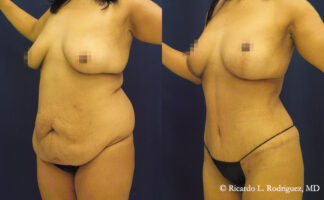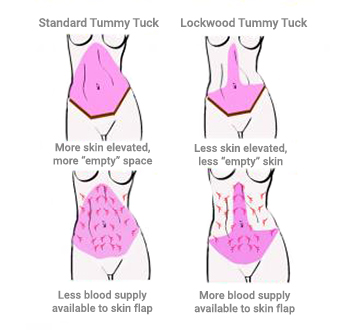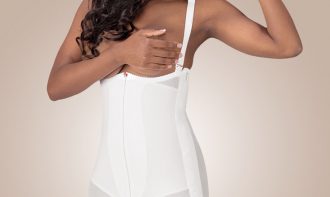What is a Tummy tuck?
Dr. Ricardo Rodriguez has performed over 1,000 tummy tuck procedures, helping patients in Baltimore and the greater DMV region achieve a flatter, more sculpted abdomen.
Do you have loose hanging skin around your stomach or hips? A Tummy tuck, or Abdominoplasty, is the most effective way to tighten your stomach area and remove excess hanging skin.
The most common types of Tummy tucks are:
- Standard Tummy Tuck
- Mini Tummy Tuck
- Dermolipectomy, aka Panniculectomy
- Extended Tummy tuck
All of these procedures can be performed as an outpatient surgery under IV sedation or general anesthesia. At our Quad A-accredited surgical facility, we prefer IV sedation, as it significantly reduces the risk of pulmonary embolism associated with general anesthesia. IV sedation is a gentler alternative, providing a smoother recovery with little to no nausea.
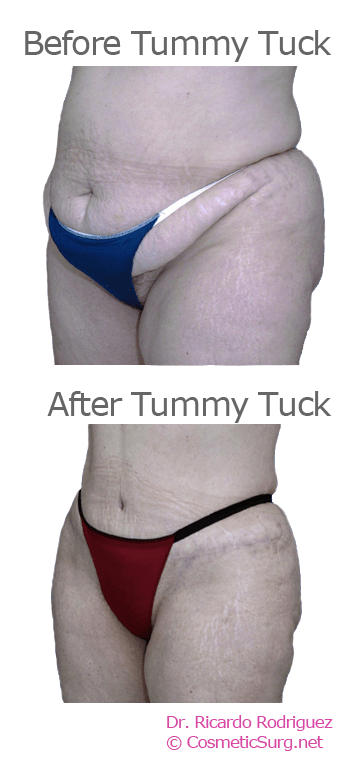
What are the different types of Tummy Tucks?
The Standard tummy tuck addresses the three components of your abdomen: the skin, fat, and muscle. The abdominal muscles are tightened and shut close, and a large segment of skin and fat is removed from your abdomen area.
A Mini tummy tuck is best suited for women who only have a pouch below the belly button. The procedure can be done through an incision in the belly button, or through a C-section scar if the patient wants a little excess skin taken off.
A Dermatolipectomy is only the removal of the excess skin. There is no muscle work. This is also known as a panniculectomy. If you have good muscle tone and a lot of hanging excess skin, this is the procedure for you.
The Extended Tummy Tuck does all the same things as a Standard Tummy Tuck, except the incision is extended further out. The incision goes beyond the hips to remove skin over your hips. It does wonders for the buttocks, as it can make your butt appear lifted. For patients who have lost a lot of weight, this is commonly the best option.
Plus Size Tummy Tucks
Dr. Rodriguez specializes in Plus size Tummy Tucks . These are patients who have BMI’s higher than 32, but less than 35. Patients who have higher BMI’s do have higher risks with anesthesia and healing. Dr. Rodriguez reduces anesthesia risk by using IV sedation, instead of General Anesthesia.
What problems does a Tummy tuck address?
No matter how much I exercise, I can’t get rid of this belly pouch.
Use AI tools to summarize this page:
There are three problems that the standard tummy tuck procedure addresses. Patients usually have these three complaints:
- Loose skin, and stretch marks: This can be a result of aging, pregnancy, or marked weight loss.
- Excess fat tissue: The lower abdomen and flanks (love handles) are the most common areas of fat deposits.
- Abdominal muscle separation: This can occur by itself or as a result of pregnancy. Sit-ups or crunches don't help in this situation as once the muscles relax, they separate and the tummy bulges out.
Will a Tummy tuck tighten the skin that hangs over the sides of my hips?
If you have excess skin and fat that hangs over your hips, you should consider an Extended Tummy Tuck or lower Body lift procedure. The body lift includes an Outer thigh lift and Buttock lift, in addition to the abdominoplasty.
Finding out if a Tummy tuck is right for you
In the video More Exercise or a Tummy Tuck?, Dr. Rodriguez explains how to examine your abdomen to determine whether separated stomach muscles (rectus diastasis) could be the cause of a protruding belly. If you have this type of muscle separation, no amount of exercise will flatten your stomach, the muscles must be sewn back together as part of a Tummy Tuck procedure. While this self-check can be helpful, a consultation is the best way to confirm whether surgery is right for you.
Dr. Rodriguez and his staff were nothing less than phenomenal! After reading reviews on RealSelf, I went in for a consultation for abdominoplasty and liposuction. Dr. Rodriguez explained the entire procedure and set clear expectations. I was sold by his calmness and humor. I would definitely recommend.
Uniquely Sue
How is a Tummy tuck performed?
The standard tummy tuck procedure takes approximately 3-4 hours of operating room time and is typically an outpatient procedure. I prefer the use of monitored IV sedation instead of General Anesthesia because patients experience much less nausea and a quicker recovery.
When are the Surgical Markings made?
On the morning of your procedure, while you are still awake, I make the surgical markings on your stomach with you in front of a mirror. I review the exact incision location with you and make every possible effort to keep the incision below your panty line.
General Anesthesia or IV Sedation with Propofol?
I prefer to use IV sedation for tummy tucks. IV sedation provides for a quicker recovery than General anesthesia. Patients have little, if any nausea. In addition, the risk of pulmonary embolism is nearly eliminated with the use of IV anesthesia.
Dr. Todd Hobelmann, one of our board-certified anesthesiologists has a great explanation of the advantages of IV anesthesia, a video filmed at our Surgery Center.
To ensure the highest level of safety for your procedure, I employ only board-certified anesthesiologists in my accredited plastic surgery surgical center in Baltimore.
What section of skin and fat will be removed?
Once the procedure starts, the first step is to place the incision between the belly button and the top of the pubic hair. I use the surgical markings that I made with you in the morning as my guidelines. We always strive to place the incision as low as possible.
However, if you have an existing C-section scar, the incision may be placed there. This will be decided with you the morning of surgery.
How are the rectus abdominis muscles tightened?
In addition to cutting out a huge wedge of skin and fat, the Tummy Tuck tightens the rectus abdominis muscles. Separated rectus abdominis muscles is another reason why the abdomen will stick out. The muscles are tightened vertically from the pubic bone to the ribs.
How is the Belly Button made in a Tummy Tuck?
Your belly button will be preserved, but it is pulled through an incision made for it's new location. After the skin is pulled down, the belly button incision is made and the belly button is pulled through to its new skin location.
How is Tissue Dissection and Wound Closure Performed?
I pay special attention to not only the placement of the scar but also the way I close and suture the wound back together. I believe that my closure technique using the Lockwood technique results in a thinner scar.
In summary, the Lockwood technique does the following:
- reduces hematoma and seromas
- thinner incision and scar (since the scar will spread less with less tension)
- preserves blood and nerve supply much better than traditional technique
For more information, watch me go into detail in the Lockwood Dissection Explained or check out this shorter Lockwood method video.
Dr. Rodriquez and his staff were exceptional. My incision is very thin and almost not noticeable. It's hidden when I wear a bikini or my underwear.
realself patient
Tummy Tuck Incision: Regular Tummy Tuck or Extended?
Do you have loose skin over your hips? If yes, you will likely need the Extended Tummy tuck. Here is a comparison:
Where is the Regular Tummy tuck incision placed?
A standard tummy tuck incision goes from hip bone to hip bone, all on the front side. This is technically known as iliac crest to iliac crest. However, if you have loose skin at the hip bone, the surgeon may recommend having an Extended Tummy Tuck.
Where is the Extended Tummy Tuck Incision placed?
For the extended tummy tuck, we remove loose skin to extend to the hip bone or even further around the back. The Extended Tummy Tuck does wonderful things for the buttocks profile, as it can also somewhat lift the buttocks.
Watch Regular vs. Extended Tummy Tuck Scars: What to Expect for an illustrative explanation!
What is Exparel used for?
Exparel is a non-opiod pain injection. To help minimize the pain during your post-op recovery, we use Exparel injection, which numbs the area. This injection is given at the end of the procedure. This is now used in place of a pain pump. The numbing medication injected into the incision dramatically reduces the post-operative pain for up to 3 days.
Will I need drains with my Tummy Tuck?
Whether or not drains are needed depends entirely on your anatomy and how the procedure is performed. Dr. Rodriguez offers both traditional and drainless tummy tuck options—not based on trend, but based on what will ensure the safest recovery and the best long-term results.
Drainless Tummy Tuck
When appropriate, Dr. Rodriguez may use internal sutures to perform a drainless tummy tuck. But what truly sets his approach apart is the technique he uses in every case: the Lockwood technique, which involves undermining less tissue from the start.
This method preserves more blood vessels and nerves, minimizes trauma, and improves healing—with or without drains.
Dr. Rodriguez shares more about his approach in his drainless tummy tuck video, where he explains how he prioritizes both safety and natural healing along with the best possible outcomes.
When drains are needed
In cases where internal sutures aren’t the best option—based on your unique anatomy—Dr. Rodriguez may use small surgical drains to manage fluid buildup during the early healing phase. Drains are typically removed within a few days.
Regardless of whether drains are used, he always performs the tummy tuck using the Lockwood technique, which helps preserve blood flow, reduce the risk of complications, and promote a smoother recovery.
It's not about drains or no drains. It's about doing the procedure in the safest way for the best healing and spectacular, long-term results.
What are the preoperative requirements?
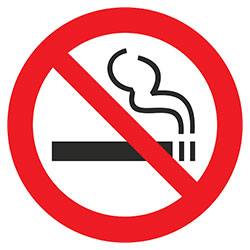
You should have met your surgeon in person at least once, if not twice before your procedure. He/she should have explained alternative treatments and given you a copy of the Informed Consent for Tummy Tuck.
Your BMI must be less than 35
The pre-op Tummy tuck requirements are these:
- Your BMI (Body Mass Index) must be less than 35 kg/m2.
- Quit smoking 2 weeks before surgery
- Physical exam and CBC within 30 days of surgery
- Schedule a pre-op appointment with your surgeon to review the surgical plan
- Read and sign the Informed consent document.
- NPO (nothing to eat or drink) after midnight before surgery
- On the morning of surgery, ask your surgeon WHERE your incision will be located!
What is Tummy tuck Post-Op recovery like?
Following a Tummy tuck, you should plan to take a minimum of 2 weeks off from work. You should not drive for 3 weeks.
Post-Operative Tummy Tuck Recovery Instructions
- Day 1 - 5: Bed rest, no showers, do not remove the garment!
- Day 6-7: First post-op office visit to remove pain pump and drains, and change garment
- Day 1 - 14: Wear compression garment 24 hours/ day
- Week 4: Follow up appointment in the office, resume driving, back to FT work
- Week 6: Resume all regular activities
The week-by-week summary of the postoperative period is described in this Tummy Tuck recovery article.
Why do I need to wear a Compression Garment?
A key component of your Tummy tuck recovery is the compression garment. This garment is important during the postoperative period. It helps the area to heal evenly and smoothly. It is worn continuously for the first two weeks post-operatively.
To learn more please read my article about the compression garment and its importance to a successful tummy tuck result.
How much weight will I lose with a Tummy Tuck?
According to a recent publication in the Journal of Plastic and Reconstructive Surgery the average tummy tuck patient maintains a weight loss of 5.77 pounds during the first three months.
This study was a retrospective study based on 188 Tummy Tuck procedures. The publication supports the findings that weight loss during the tummy tuck post operative period is maintained over the next 5 years, with some patients losing even more weight.What are the risks and possible complications?
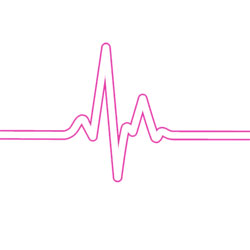
This 4% complication rate was based on an analysis of 25,478 abdominoplasty patients. The most common major complications outlined by the study were found to be hematoma (1.3%), and infection (1.1%).
The list of all risks and complications of the Tummy tuck procedure includes, but is not limited to:
- scarring
- seroma (fluid collection)
- hematoma
- asymmetry
- infection
- loss of skin
- loss of sensation
- possibility of revision surgery
How much does a Tummy tuck cost?
When evaluating costs, consider the 'total cost' including the surgeon's fee, operating room fee, anesthesia fee, post-op garments and visits.
To compare apples to apples, be sure to know if you are getting a Tummy Tuck or an Extended Tummy Tuck!
Tummy Tuck Total costs for 2025 in our Baltimore facility are as follows:
| Type of Tummy Tuck with or without Liposuction | 2025 Prices |
|---|---|
| Tummy Tuck | $8,800 |
| Tummy Tuck + Lipo Love Handles (front flanks) | $10,200 |
| Tummy Tuck + Lipo Flanks (love handles and back muffin top) | $11,900 |
| Extended Tummy Tuck only | $9,500 - $11,000 |
| Extended Tummy Tuck + Lipo Flanks (love handles and back muffin top) | $12,300 - $14,400 |
| Dermolipectomy / Panniculectomy | $6,500 |
Does the Extended Tummy Tuck cost more than a standard Tummy Tuck?
Yes, the Extended Tummy Tuck does cost more because it takes longer in the operating room to remove more excess skin around the hip.
Can I add liposuction to my Tummy Tuck?
Yes. You can add the front flank liposuction (love handles) for a total cost of $9,400. If you want liposuction to full flanks, (love handles and muffin top above the buttocks), the total cost averages $11,900.
You can also add additional areas of lipo such as your scapular (back), inner thighs, or neck area.
What are average Tummy Tuck prices in Baltimore?
Patients often want to know how our price compares to other Plastic Surgeons in the area. We conducted a survey of the top 10 tummy tuck surgeons in Baltimore to find out what the average standard and extended tummy tuck prices are in our area.
I am so very Thankful for Dr. Rodrigues and his entire team. I had a few consultations for a Tummy Tuck following my natural weight loss of 100lbs but I knew Dr. Rodriguez was the one for me from the moment we met.
realself patient
Can I finance my Tummy Tuck?
Yes, we offer 6-month, no-interest financing to make your procedure more affordable. Call us at 410-404-8100 or see our financing page for additional financing information.
Dr. Rodriguez: Trusted tummy tuck surgeon in Baltimore
With more than 25 years of experience and over 1,000 tummy tuck procedures performed, Dr. Ricardo Rodriguez helps patients from Baltimore, Towson, Columbia, and beyond achieve flatter, more sculpted abdominal contours. Every procedure is tailored to your unique body and goals for natural-looking, confidence-boosting results.
In addition, Dr. Rodriguez can perform Plus-size tummy Tucks for patients with BMIs between 32-35.
Our Quad A-accredited facility ensures the highest level of safety, using IV anesthesia with Board-Certified Anesthesiologists. Plus, all patients receive direct access to Dr. Rodriguez’s cell phone post-surgery for personalized care.
Dr. Rodriguez is recognized by RealSelf for his extensive experience and expertise in tummy tuck surgery and serves as a medical content reviewer on their platform.
Ready to explore what's possible?
BOOK A COURTESY CONSULT TODAY!
We're looking forward to helping you look and feel your best,

Board Certified Plastic Surgery, ASPS Member
NOTICE
Patients depicted in our before and after galleries have provided their written consent to display their photos online. Every patient is unique, and surgical results may vary. Please contact us if you have any questions.

